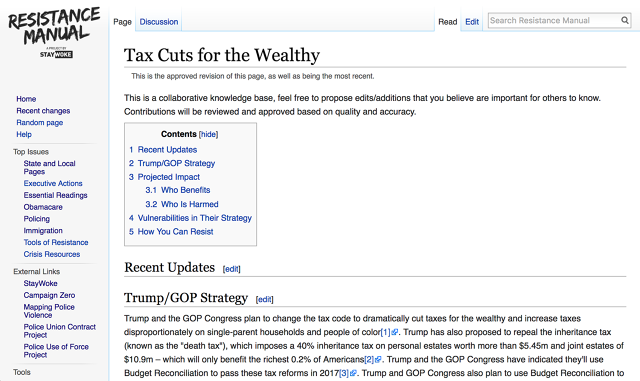No one was more blindsided by Donald Trump’s election victory than liberals who had been so confident in a Hillary Clinton win. November’s unexpected loss left many of them scrambling for ways to respond, and within weeks they did, thanks to online collaboration tools—everything from wikis to Google Docs—that mobilized hundreds of thousands of volunteers almost instantly.
The result is a newly galvanized political opposition focused on resisting Trump’s agenda and reinstalling the Democrats to power. It’s a likeminded collective whose rapid organic growth mirrors that of a very different political force that emerged eight years ago.
“It’s very, very similar to the way that the Tea Party started,” says Sarah Dohl, a former staffer for Democratic Congressman Lloyd Doggett of Texas, who watched the rapid rise of the anti-Obama movement in 2009 and 2010. In late November and early December 2016, Dohl and other Hill veterans created an online handbook for liberals called Indivisible Guide, based on the same political-organizing strategies that were effective against the Democrats.
After Trump’s election win, Dohl says she and her collaborators “saw a lot of very well-meaning people giving very bad advice.” People suggested signing toothless petitions or calling Speaker of the House Paul Ryan, for instance. “Having worked in these offices, we know that if you don’t live in the First District of Wisconsin, Paul Ryan doesn’t work for you, and he does not care what you have to say,” she says. Since its launch in December, Indivisible Guide has spawned over 4,500 groups that lobby their local members of Congress, says Dohl, and over 600,000 people have searched the site for a group to join.
And last week, the people behind the guide announced that they had filed to become an official nonprofit organization. It’s one of a number of crowdsourced anti-Trump groups to spring up quickly since the election—a consequence of an upset that few had predicted.
“Had there been a clear possibility through the election cycle that Trump would have won the election, I think people might have geared up sooner,” says Jan Miksovsky, who founded Presterity, which is essentially a Wikipedia for tracking news about the Trump administration. After launching the day before Trump’s inauguration, the site already has about a dozen sections on such topics as federal departments, foreign policy, and Trump’s cabinet. Presterity is a portmanteau of “press” and “posterity,” and was conceived around Thanksgiving.

Miksovsky, who founded the Seattle web-development firm Component Kitchen, has a long history in the tech sector, as do several of the early volunteers who helped create Presterity. But time was tight when they were building it, so they went with wiki software called Confluence from the enterprise software maker Atlassian. “We were able, within a few minutes, to have a wiki to start from,” Miksovsky says.

Anyone can submit articles to Presterity through the free bookmarking app Raindrop. It allows them to rename, annotate, and tag the links before sending them to Presterity’s volunteer moderators for review. People don’t have to join the organization to submit news, nor is there a political test. “I’m eager to find conservatives that share our concerns and listen to our cause,” says Miksovsky.
SwingLeft, an organization focused on flipping the House of Representatives to Democrat control in the 2018 elections, also started on the eve of Trump’s swearing in—this one with emails and social media posts calling for volunteers. Over 250,000 people have since signed up, pledging to help on campaigns in the 52 “swing districts” that could easily go Democrat or Republican in 2018. These and other organizations have popped up without staff or much money, relying on a lot of volunteers who can each do a bit of work.
“You don’t need to have 30 years in a field to have an impact,” says 26-year-old Samuel Sinyangwe, who launched an anti-Trump information site similar to Presterity, called Resistance Manual, on January 17. “What we’re trying to do is create a broader resource that contains a lot more information about the issues and why they matter to people,” he says. Resistance Manual runs on the same free software, MediaWiki, that powers Wikipedia, so newcomers already know how to navigate it.

From Barroom To Google Doc
Indivisible Guide began in Austin, Texas, with a barroom chat on Thanksgiving Day between wife-and-husband team and former Hill staffers Leah Greenberg and Ezra Levin, along with their friend Sara Clough. It grew to a group of about 30 who collaborated on a Google Doc, and then it went live with a tweet and a Facebook post on December 14. Indivisible Guide took off on social media, and the press picked it up almost immediately.
Traffic soon overwhelmed the Google Doc, and the group needed to transition to a website, pronto. “When we launched our website, we went with Squarespace, just because it was the easiest way to get a site up in 12 hours,” says Dohl. The core group, which has expanded to about 70, includes developers who are already working to revamp the site, likely moving it to a more sophisticated platform. Presterity is doing the same. “We can gradually migrate bits and pieces over to something that’s custom-built for our needs,” says Miksovsky.
The ease of setting up new networks could result in too much of a good thing for activists, however. “The internet, as a distributed system, crowdsources research, questions, answers, and actions,” writes tech and marketing analyst Jeremiah Owyang in an email. “The downside is there’s often not a clear leader, and groups can splinter, resulting in multiple groups repeating the same work as a similar group.”
That doesn’t seem to be happening too much yet, and organizers say there is already talk of teaming up. “We have been talking and exploring options for coordination with Indivisible and other organizations in the space, for sure,” writes Michelle Finocchi, one of the SwingLeft leaders, by email.

The Alt-Fact Alternative
Politics has always been a battle of alternative ideas, but now it’s one of “alternative facts,” in the words of presidential counselor Kellyanne Conway. Fake news sites are thriving, and Donald Trump has said many things that are verifiably false.
Despite denying it in a debate, Trump did tweet that global warming was made up by the Chinese, for instance. You can look up that one, and every other missive, on the Trump Twitter Archive site created by Brendan Brown. The president also repeats unsubstantiated claims about voter fraud costing him the popular vote; and he exaggerates inauguration turnout figures in defiance of photographic evidence and public-transit ridership numbers.
All of this makes the task of tracking the president’s actions even more difficult. “There’s deep concern with the way he and his team play fast and loose with the truth,” says Miksovsky.
Meanwhile, media-fueled distractions abound: Endless debates about inauguration and protest turnout drown out reporting on signed executive orders or suspended programs. It’s too big a project for one person. Just ask an anonymous activist who goes by the online handle motocollard. In November, he started to build a public Google spreadsheet to track erratic behavior on the part of the president. “No crowdsourcing. Which is probably why I burnt out in December. Trying to find the right balance,” motocollard told me in a Twitter chat. (He declines to provide his real name for “privacy concerns,” he says.)
On November 20, motocollard’s project got a shoutout from Atlantic writer James Fallows, who had been authoring a series of columns, called the Trump Time Capsule. “Its purpose is to catalogue some of the things Donald Trump says and does that no real president would do,” as Fallows described it. In the same post mentioning motocollard, Fallows also pledged to evolve the Time Capsule into an ongoing research project to chronicle the new administration.
But that project hasn’t materialized yet, so Miksovsky and friends built their own, as did Resistance Manual’s Samuel Sinyangwe: The wiki covers 15 areas, such as Obamacare, immigration, mass Incarceration, and climate. All of the entries are action-oriented, ending in a “How You Can Resist” section that mainly recommends contacting public officials. “It’s a living document that can change and adapt,” says Sinyangwe.
Mapping Police Violence uses crowdsourced reporting to track fatal encounters between blacks and police.
Sinyangwe was already a data activist. In March 2015, he built a site called Mapping Police Violence. It displays fatal U.S. police encounters, by year, on a national map and in other graphics. In lieu of comprehensive official statistics, Sinyangwe joined up with Black Lives Matter leaders DeRay McKesson and Johnetta Elzie, whom he met on Twitter, to collected figures from three crowdsourced databases of police shootings and fed the figures into data-visualizing software Carto. “One look at that map, in two seconds, you knew this was happening everywhere,” he says. “It wasn’t just a Baltimore problem or a Ferguson problem.”
On his first day in office, President Obama signed the Memorandum on Transparency and Open Government. One of its products was Data.gov, a portal designed to make government information more accessible to the public. The administration encouraged citizens to slice and dice data and propose ways to make government run better. Data.gov is still online, but other sources of information may be in jeopardy under the Trump administration.
“My sense is that this top-down trend is going to die under Trump, at least in government,” Hélène Landemore, a Yale political science professor and author of the book Democratic Reason: Politics, Collective Intelligence, and the Rule of the Many, wrote by email. “But now we see a similar movement emerging among activists who have embraced the idea of crowd power and crowd intelligence as a possible check against state power.”

The Necessity Of Crowds
Since the election, sizable national organizations have emerged almost instantly, overwhelming the handfuls of people who started them. “We all have day jobs, we all have families,” says Miksovsky. And clearly, that’s not an exaggeration. In reporting this story, I traded emails with, and Twitter-stalked, apologetic organizers who kept reminding me that they are volunteers. By the time I got Sarah Dohl from Indivisible Guide on the phone, she was battling pneumonia.
Sustaining the effort requires dividing big tasks among a lot of people online. “The tools that we’re talking about—wikis, social media—those are becoming more mainstream,” says professor Anatoliy Gruzd, who focuses on social media at Ryerson University in Canada. “So more people can be able to contribute to those tools, where before you had only very small niche groups—groups of advocates.”
The Black Lives Matter movement has taken advantage of the trend. In August 2015, the activists behind Mapping Police Violence cofounded Campaign Zero, a project with the lofty goal of eliminating violent interactions between the police and the public. The group created a 19-question survey with the free online tool Typeform, asking about people’s skills, areas of interest, and availability to volunteer. In two weeks, Campaign Zero had 17,000 people researching issues, developing proposals, and planning political action. “That is sort of a pilot program to what is needed now,” says Sinyangwe about plans to expand into overall Trump resistance.

Success for such groups requires avoiding many organizational perils. Gruzd and Landemore point to the 2013 Boston Marathon bombing as a major step in crowdsourced research. The FBI asked anyone who had possible evidence, such as photos and videos, to share them with investigators. That part was very successful, with the manhunt concluded in just over four days. But the call also led to crowdsourced detective work by amateurs in forums like 4Chan and Reddit that led to mistaken allegations, casting suspicion on innocent bystanders. “Absolutely, there’s danger of crowdsourced tasks like that,” says Gruzd.
But while the Boston Marathon effort was on the border between the wisdom of crowds and mob rule, the new anti-Trump projects have a core group of people who vet volunteers to weed out troublemakers and check submissions for misinformation. “Wikipedia is a very good example of the moderation part,” says Gruzd. “It’s actually a very hierarchical structure, so there’s very few people who would be allowed to do any corrections.”
These are the early days of a new insurgency on the left. Activists are bootstrapping and figuring it out as they go along—not unlike how the insurgency on the right began in 2009. Just as the Tea Party evolved into a collection of disciplined and well-funded organizations, the new left groups are already starting to solidify their structure.
“There is a tendency of projects like that, which may start in a decentralized nature . . . to quickly become more centralized,” says Gruzd. He says that’s because the groups that set them up realize that they have to be managed if they are to thrive. But everyone I spoke with, Gruzd included, says that crowdsourcing is here to stay, be it in politics, business, academia, or other endeavors. The extent to which the crowd will participate is still very much in flux, but then so is everything else in U.S. politics today.
Fast Company , Read Full Story
(20)